Freezing temperatures damage plants by causing ice crystals to form in their cells. Frost-damaged vegetation withers and turns a dark brown or black. Ice crystals can also form in citrus fruit, causing juice vesicles inside the fruit to rupture and the fruit to dry out. Although frost-damaged fruit is edible after a freeze, it is susceptible to decay and often becomes unusable soon after the damage occurs.
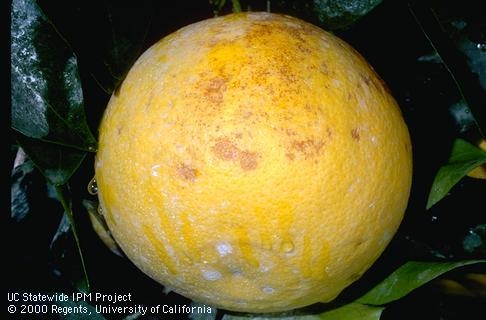
Different types of citrus vary in cold hardiness. Mandarins and kumquats are the most cold hardy varieties of citrus trees. Mature mandarin trees, for example, can tolerate temperatures down to 20° for 4 hours before serious damage occurs to the wood. For Meyer lemons, the critical temperature is 22°, while oranges can sustain serious damage to the tree after 4 hours at 24°. The critical temperature for grapefruit trees is 26°. Keep in mind that these are general temperature figures. Other factors may interact with cold temperatures to influence the extent of frost damage. For example, greater damage results when cold temperatures occur over a longer time period. Mandarin fruit will tolerate a brief exposure to 24°, but several hours at 26° will begin to freeze the fruit.
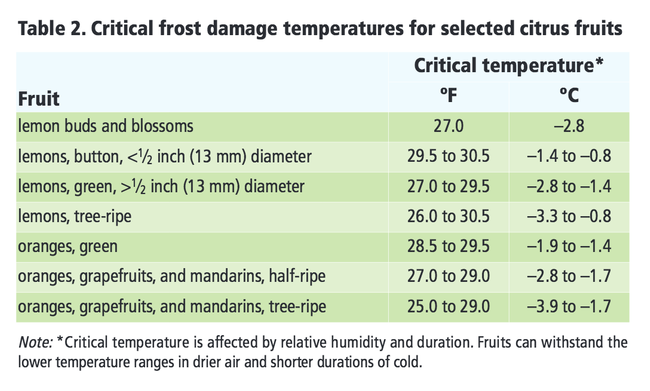
Certain cultural practices can also mitigate frost damage. Healthy, well-irrigated trees are better able to endure freezing temperatures. The full, leafy canopy of a healthy tree also helps shelter the fruit. In addition, moist soil retains heat better than dry soil and can actually warm the air near the soil surface. It is also a good idea to keep the ground around trees bare during the winter months. Bare, moist soil is better able to absorb and reradiate heat than soil insulated with mulch, weeds, or other ground covers. Fertilizing and pruning both encourage new growth, and delicate new growth is far more frost-sensitive than mature foliage. Thus, pruning and fertilizing of citrus trees should occur in the spring and early summer in order to give the new vegetation time to mature and harden off before cold weather sets in.
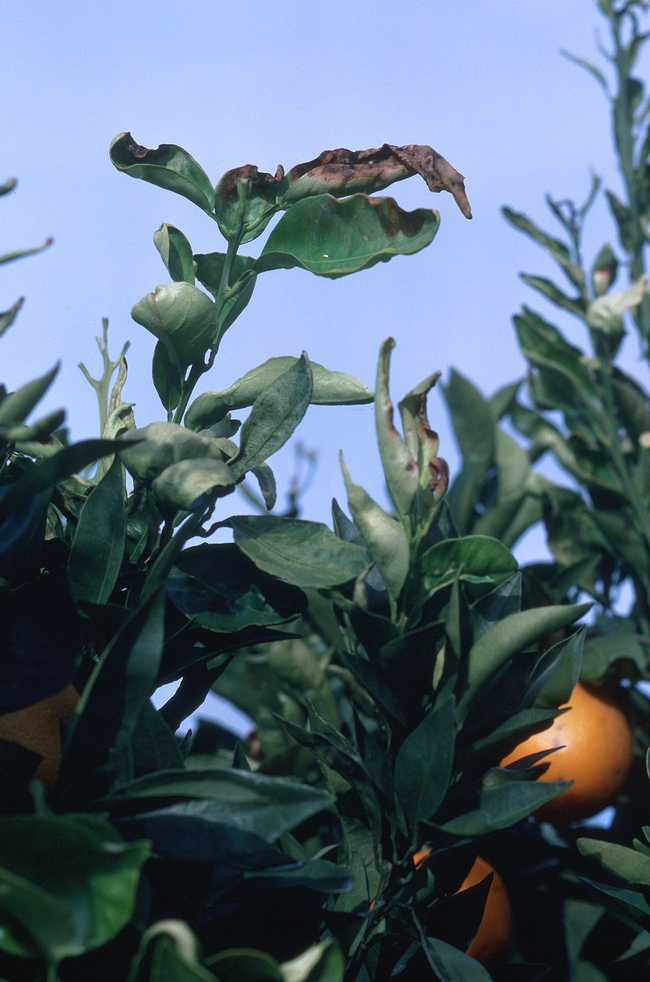
Frost-sensitive young trees can be protected by wrapping them with insulating material from the ground up to the main branches. In frost-prone areas, you might also consider covering trees that are one to three years old entirely, using a light material to trap heat being radiated by the ground. A frame or stakes should be used to minimize contact between the cover and leaves because ice may form where the cover touches any leaves. Sheets, burlap, or tarps are a better choice of cover material than plastic because plastic transfers more heat and if leaves come in contact with it they are more likely to freeze. The cover should extend as close to the ground as possible and be removed the next morning after the temperature rises.
If trees do show signs of frost damage, resist the urge to prune out “dead” wood in the early spring. Allow a few months for the trees to recover with the return of warm weather. Once new growth appears, the actual extent of the frost damage will be apparent and frost-killed branches can be removed without accidentally pruning out living material.
For more information download the free UC ANR publication 8100 on Frost Protection for Citrus and Other Subtropicals.
UC Master Gardeners of Butte County are part of the University of California Cooperative Extension (UCCE) system. To learn more about us and our upcoming events, and for help with gardening in our area, visit our website. If you have a gardening question or problem, email the Hotline at mgbutte@ucanr.edu (preferred) or call (530) 538-7201.
- Author: Brent McGhie
By Brent McGhie, Butte County Master Gardener, January 6, 2017.
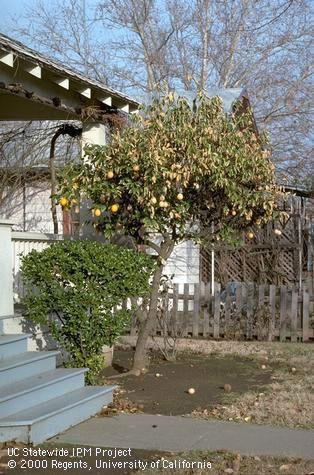
Plummeting winter temperatures often lead to frost damage in plants. The damage occurs when ice crystals form within plant tissue, damaging their cells. Leaves and tender new growth are usually affected first. Initially, they will appear wilted. Then the wilted growth will turn brown or black and eventually become crispy. This means these affected parts of the plant have died.
It is tempting to remove frost-damaged plant growth immediately, but dead material should be left on the plant until the full extent of the damage is apparent in the spring. There are several reasons to wait. By allowing plenty of time for new growth to appear, the extent of any damage will be clearly apparent and it will be less likely that you will accidentally remove living tissue that survived a freeze. Additionally, dead material can actually provide an insulating effect and removing it too soon may expose additional tissues to future freezes. If you prune out dead material before another freeze hits, it is more likely that an even greater portion of the plant will be killed. In Chico and nearby areas of the valley floor, the danger of frost is usually over in late April, so it is prudent to wait at least until then, or later, before doing any pruning.
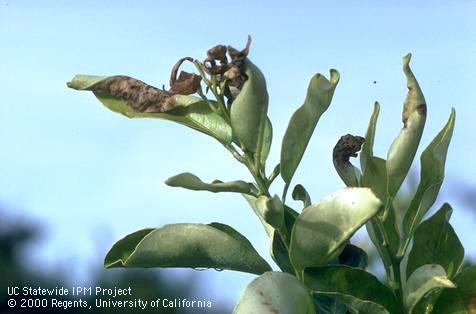
In citrus, if hardier growth (such as twigs or wood) has not been seriously damaged, it is normal for dead leaves to be rapidly shed. If the frost-killed leaves remain on the plant, this is an indication that twigs or branches have been seriously damaged. If larger branches or the trunk of a tree sustain cold damage, the bark will split and dead patches of curled, dry bark may appear. If a young citrus tree has been killed nearly to the ground, inspect it closely to determine if the damage extends below the graft union. The graft union is the junction where the fruit-producing part of the tree was grafted onto the rootstock. If new growth comes only from the rootstock, the tree will no longer be true to the type you originally planted and will usually be unproductive. In this case, the tree should be replaced or you can try your hand at budding a new top variety into the rootstock sprouts in late spring.
The only thing that should be done immediately after frost damage has occurred to citrus and other woody plants is whitewashing. Whitewash should be applied to the trunk and exposed limbs. This protects the bark from sunburn, which is more likely to occur if a plant becomes defoliated. Frost-damaged plants are more susceptible to disease and insects and sunburn increases this susceptibility. To make whitewash, mix equal parts of white interior latex paint with water. If the area to be painted is particularly rough and fissured, a thinner mixture can be applied for better penetration and coverage. You can dilute a thicker top-quality interior latex paint as much as 2:1 or 3:1, water to paint.
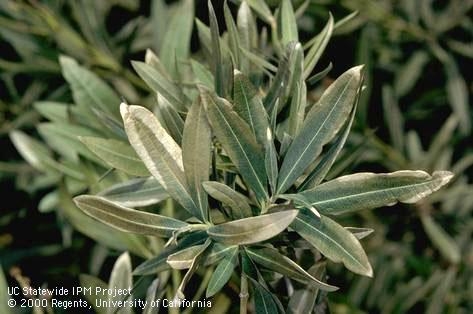
It is also important to note that frost-damaged plants are unbalanced: although their leaves have been reduced, they still have the same root system. This can result in extensive new growth over the entire plant once regrowth begins in the spring. To ensure that the plant reaches an acceptable balance between its leaves and its root system, the new shoots should grow at a moderate rate. It is recommended that little or no fertilizer be applied to these plants initially, and they should be irrigated less than usual until they have returned to a normal appearance. Too much nitrogen fertilizer, for example, can encourage sucker and water sprout growth, while too much water can damage roots.
Of course, it would be preferable to prevent frost damage from occurring in the first place. To read more about preventing frost damage and many other gardening topics, visit the Butte County Master Gardener website (http://ucanr.edu/sites/bcmg/). For specific information on frost protection, the following link will take you to our Real Dirt blog page on this topic: Frost Protection for Citrus
See also:


